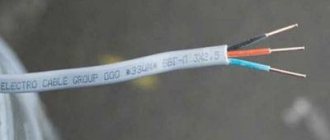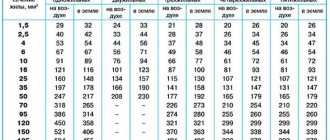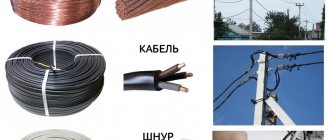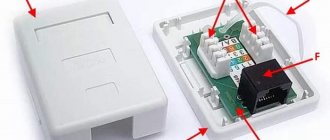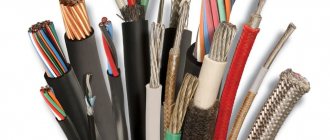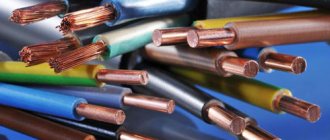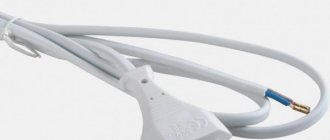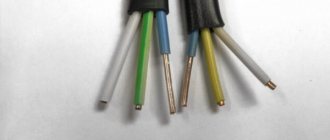SIP design
The phase aluminum wires are coated with a light-stabilizing black insulating coating. The polyethylene coating is highly resistant to moisture and ultraviolet sunlight, which destroy rubber or conventional polymer insulation.
The wires are twisted into a bundle around a zero aluminum core, in the center of which there is a steel wire. The core of the neutral core is the supporting basis of the entire cable. Some designs of SIP cables with a small cross-section and a small number of cores are light in weight, since these types do not have a steel core. SIP stands for self-supporting insulated wire.
Types and structure
Five main types of SIP wires are produced:
- SIP-1 includes three phases, each of which is twisted into a bundle of several aluminum wires around an aluminum alloy core. The wires of the fourth neutral core are twisted around a steel core. The phases are insulated with UV-resistant thermoplastic. On the SIP-1A cable brand, the neutral wire, like the phase conductors, is in an insulated sheath. Such cables can withstand prolonged heating times at 70°C.
Cable design SIP-1, SIP-1A
- SIP-2 and SIP-2A have a similar design to SIP-1 and 1A, the only difference is in the insulating shell. The insulation is “cross-linked polyethylene” - a connection of polyethylene at the molecular level into a network with wide cells with three-dimensional cross-links. This insulation structure is much more resistant to mechanical stress and can withstand lower and higher temperatures during prolonged exposure (up to 90°C). This allows the use of this brand of SIP cable in cold climates under heavy loads. The maximum voltage of transmitted electricity is up to 1 kV.
- SIP-3 is a single-core cable with a steel core, around which wires made of AlMgSi aluminum alloy are twisted. The insulating shell made of “cross-linked polyethylene” allows the use of SIP-3 for the construction of overhead power transmission lines with voltages up to 20 kV. The operating temperature of the cable is 70°C, it can be used for a long time at temperatures ranging from minus 20°C to + 90°C. Such characteristics allow the use of SIP-3 in various climatic conditions: in temperate climates, cold or in the tropics.
Internal structure of the SIP-3 cable
- SIP-4 and SIP-4N do not have a neutral wire with a steel rod; they consist of paired wires. The letter H indicates that the wires are made of aluminum alloy. PVC insulation is resistant to ultraviolet radiation.
Design of self-supporting insulated wire SIP-4
- SIP-5 and SIP-5N - two cores have a similar structure to SIP-4 and SIP-4N, the difference is in the insulating sheath. Cross-linked polyethylene technology allows you to increase the operating time at the maximum permissible temperature by 30 percent. Power lines using SIP-5 are used in cold and temperate climates, transmitting electricity with voltages up to 2.5 kV.
Internal structure of self-supporting insulated wire SIP-5
Depending on the operating conditions and the load of electricity consumed, the brand and cross-section of the SIP cable are selected.
Selection of SIP section
The selection and calculation of the cross-section of SIP wires for connecting various consumer objects is carried out using the classical method. The maximum power consumption of electrical installations is added up, and the current load is calculated using the formula:
I = P\U√³, where
— P – total power consumption;
— I – maximum current consumption;
— U – network voltage.
Based on the value of the maximum current, you should select the required cross-section of SIP wires using pre-calculated tables.
Parameters of the most used SIP cables for connecting buildings from the main power lines (SIP-1, SIP-1A, SIP-2, SIP-2A)
| Section in mm and number of cores | Phase resistance in Ohm per 1 km | Maximum permissible phase current with thermoplastic insulation | Maximum permissible phase current with cross-linked polyethylene | Short circuit current in kA for a duration of 1s |
| 1x16+1x25 | 1.91 | 75 | 105 | 1 |
| 2x16 | 1.91 | 75 | 105 | 1 |
| 2x25 | 1.2 | 100 | 135 | 1.6 |
| 3x16 | 1.91 | 70 | 100 | 1 |
| 3x25 | 1.2 | 95 | 130 | 1.6 |
| 3x16+1x25 | 1.91 | 70 | 100 | 1 |
| 3x25+1x35 | 1.2 | 95 | 130 | 1.6 |
| 3x120 +1x95 | 0.25 | 250 | 340 | 5.9 |
| 3x95+1x95 | 0.32 | 220 | 300 | 5.2 |
| 3x95+1x70 | 0.32 | 220 | 300 | 5.2 |
| 3x50+1x95 | 0.44 | 180 | 240 | 4.5 |
| 3x70+1x70 | 0.44 | 180 | 240 | 4.5 |
| 3x50+1x70 | 0.64 | 140 | 195 | 3.2 |
| 3x50+1x50 | 0.64 | 140 | 195 | 3.2 |
| 3x35+1x50 | 0.87 | 115 | 160 | 2.3 |
| 3x25+1x35 | 1.2 | 95 | 130 | 1.6 |
| 3x16+1x25 | 1.91 | 70 | 100 | 1 |
| 4x16+1x25 | 1.91 | 70 | 100 | 1 |
| 4x25+1x35 | 1.2 | 95 | 130 | 1.2 |
When choosing the cross-section and brand of SIP wires, it is important to take into account not only the maximum current load, but also the temperature and the time during which the cable can be operated in extreme conditions. Typically, the allowable duration is between 4000 and 5000 hours.
Maximum temperature for wires
When choosing the brand of SIP cable and its heating cross-section, you must take into account the type of insulation: cross-linked polyethylene or thermoplastic. Taking into account voltage losses, thermal resistance during short circuit, mechanical strength, if one of the parameters is insufficient, a cable with a large cross-section is selected.
When operating a SIP cable, overloads are allowed up to 8 hours a day, 100 hours a year and no more than 1000 hours for the entire period of operation. Most often, SIP-2A is used to connect residential buildings or commercial facilities, this is due to some disadvantages of other cable models:
- on SIP-1 and SIP-2, the neutral conductor is not insulated; if it breaks, there may be an induced potential that is dangerous to humans;
- SIP-1(A), SIP-4 has weak insulation;
- SIP-3 is used only for voltages above 1000V, it is a single wire;
- SIP-4 or SIP-5 do not have a central load-bearing core, so they can only be used over short distances; at long intervals, the cable stretches and sag.
From the above table it can be seen that the SIP-2A cable can have the same or different core cross-sections. Typically, when the cross-section of the phase conductors is 70 sq./mm, the zero conductor for strength is made 95 mm/sq. With a larger cross-section of phases, the carrier phase is not increased; the mechanical strength is quite sufficient. With a uniform distribution of electricity across phases, the zero conductor experiences virtually no electrical and thermal load. For lighting networks, cables with a core cross-section of 16 or 25 sq./mm are usually used.
Mechanical characteristics of SIP wire
| Brand and rated voltage of the wire | Nominal outer diameter, mm | Estimated outer diameter of the wire, mm” | Estimated weight of 1 km of wire, kg |
| SIP-1-0.6/1 | 1×16+1×25 | 15 | 135 |
| 3×16+1×25 | 22 | 270 | |
| 3×25+1x35 | 26 | 390 | |
| 3×35+1×50 | 30 | 530 | |
| 3×50+1×50 | 32 | 685 | |
| 3×50+1×70 | 35 | 740 | |
| 3×70+1×70 | 37 | 930 | |
| 3×70+1×95 | 41 | 990 | |
| 3×95+1×70 | 41 | 1190 | |
| 3×95+1×95 | 43 | 1255 | |
| 3×120+1×95 | 46 | 1480 | |
| 3x150+1x95 | 48 | 1715 | |
| 3×185+1×95 | 52 | 2330 | |
| 3×240+1×95 | 56 | 2895 | |
| SIP-2-0.6/1 | 3×16+1×25 | 24 | 308 |
| 3×16+1×54.6 | 28 | 427 | |
| 3×25+1×35 | 27 | 424 | |
| 3x25+1x54.6 | 30 | 512 | |
| 3×35+1×50 | 31 | 571 | |
| 3×35+1×54.6 | 32 | 606 | |
| 3×50+1×50 | 34 | 727 | |
| 3×50+1×54.6 | 35 | 762 | |
| 3×50+1×70 | 36 | 798 | |
| 3×70+1×54.6 | 39 | 973 | |
| 3×70+1×70 | 40 | 1010 | |
| 3×70+1×95 | 41 | 1087 | |
| 3×95+1×70 | 43 | 1240 | |
| 3×95+1×95 | 45 | 1319 | |
| 3×120+1×95 | 48 | 1553 | |
| 3×150+1×95 | 50 | 1787 | |
| 3×185+1×95 | 55 | 2403 | |
| 3×240+1×95 | 60 | 2968 | |
| SIP-3 -20 | 1×35 | 12 | 165 |
| 1×50 | 13 | 215 | |
| 1×70 | 15 | 282 | |
| 1×95 | 16 | 364 | |
| 1×120 | 18 | 445 | |
| 1×150 | 19 | 540 | |
| 1×185 | 21 | 722 | |
| 1×240 | 24 | 950 | |
| SIP-3-35 | 1×35 | 14 | 209 |
| 1×50 | 16 | 263 | |
| 1×70 | 17 | 334 | |
| 1×95 | 19 | 421 | |
| 1×120 | 20 | 518 | |
| 1×150 | 22 | 618 | |
| 1×185 | 24 | 808 | |
| 1×240 | 26 | 1045 | |
| SIP -4 0.6/1 kV | 2x16 | 15 | 139 |
| 4x16 | 18 | 278 | |
| 2x25 | 17 | 196 | |
| 4x25 | 21 | 392 |
Calculation example
An example of calculating the cross-section of a SIP cable for connecting an object with a total power of electrical appliances of 72 W, at a distance from the main power line of 340 m. Supports for hanging the SIP cable should be placed at intervals of no more than 50 m, this will significantly reduce the mechanical load on the wires. The maximum current for a three-phase circuit should be calculated when all electrical appliances are turned on. Provided that the load is distributed evenly between the phases, one phase will have:
72 kW / 3 = 24 kW.
The maximum current in one phase, taking into account the inductive and capacitive load of electrical appliances (cos fi = 0.95) will be:
24 kW / (230V* 0.95) = 110A.
According to the table, a SIP cable with a cross-section of 25 A is selected, however, given the cable length of 340 m, voltage losses must be taken into account, which should be no more than 5%. For ease of calculation, the cable length is rounded to 350 m:
- in SIP, the resistivity of aluminum is 0.0000000287 ohm/m;
- The wire resistance will be Rpr. = (0.0000000287 / 0.000025) Ohm/m * 350 m = 0.4 Ohm;
- load resistance for 24 kW. Rн = U 2 * cos fi: P = 230 2 * 0.95 / 24 kW = 2.094 Ohm;
- total resistance – Rtotal. = 0.40 Ohm. + 2.094 Ohm. = 2.5 Ohm.
Based on the calculated data, the maximum current in the phase conductor will be:
I = U / R = 230V: 2.5 Om = 92 A
The voltage drop is equal to I max * Rpr. = 93A * 0.4 Ohm = 37V.
37 Volts is 16 percent of the mains voltage U = 230V, which is more than the permissible 5%. According to calculations, a SIP with a cross-section of 95 sq./mm is suitable. The losses with such a wire are 11 V, which is 4.7%. When calculating a single-phase line, the total power is not divided by 3, the cable length is multiplied by 2.
Calculation method (update from 02/19/2018)
We take plate 10 and from it we find that one core is 16 sq. mm. withstands - 100 amperes. Next, we take the following calculation formulas:
for single-phase load 220V P=U*I
for three-phase load 380V P=(I1+I2+I3)3*cos φ*1.732*0.38
update from 02/19/2018 Regarding the calculation of power for a three-phase load, you need to understand that a lot depends on the type of consumers (more precisely, what kind of load they provide active or reactive, it depends on what cos φ should be substituted into the formula, in this case for calculations it is equal to 0.95 )
Dear visitors to the site, I might not have noticed your caustic but technically correct comments on the article if just today a person called me with the question: “what kind of sip do I need for 120 kW?” According to the sign, a SIP with a cross section of 50 mm square would be perfect for him. Even if we omit the fact that the length of the line affects the voltage drop (it has 150 meters), we should not forget that the load on the phases can vary, as can be seen from the formula - it takes the average value for three phases. Here you just need to understand that the phase current can exceed the maximum permissible values for a given wire cross-section.
Therefore, if the value of the load you need is closer than 10% to the table, you should choose a larger section of the vulture from the list. Let me explain with the example of 120 kW. According to the table, for this three-phase load, a SIP with a conductor cross-section of 50 mm is suitable, but this is less than 10%. That is, 121 kW * 0.9 = 109 kW. Accordingly, you need to choose SIP 3x70+1x54.6.
At the beginning of the topic, the question was raised: “will a 4x16 15kW sip handle it?” Therefore, for a private house we multiply 220Vx100A = 22 kW per phase. But don’t forget that we have three phases. And this is already 66 kilowatts in total for a residential building. Which is a 4-fold margin relative to the issued technical conditions.
Read also: A stud broke off, how to unscrew it
Radio stations
Radio modems
GSM modems
Antennas
Power supplies and converters
Information
(495) 220-95-14 [email protected]
Explanation of SIP marking:
- C - self-supporting;
- I - isolated;
- P - wire.
The letter at the end of the marking means:
- “A” – neutral core with insulation
- “N” – current-carrying conductors are made of aluminum alloy
- “T” – insulation resistant to elevated temperatures +90°C (short-term +120°C)
- “G” – sealed (moisture will not spread along the wire more than 3 meters from damage to the insulation)
In the marking of a SIP wire, a dash sign indicates the rated voltage for which the wire is intended. Sometimes two values can be indicated here separated by a slash. For example, 0.6/1. This means that the wire is designed for voltages of 660 or 1000V.
And the last thing in the marking is the technical condition according to which the wire is made. Usually this is a set of numbers after the abbreviation TU.
Cable marking, in addition to designating a specific group, also necessarily includes the wire cross-section, date of manufacture, batch number and additional information from the manufacturer.
Installation. Video
Tips for installing SIP wires to your home are presented in this video.
It can be concluded that SIP cables have a number of advantages over older models of aluminum cables that do not have insulation. The cable is reliably protected from short circuits when laid in tree branches and other difficult operating conditions. It can be laid on the walls of buildings, structures, along fences, and does not require highly qualified workers. The absence of special supports and insulators reduces installation time and costs. Thanks to insulation and other design features, the scope of application of SIP cables has expanded significantly.
While browsing the internet for electrical installations, I found a thread on one forum discussing “whether a 4x16 sip can withstand 15 kW.” The question arises because 15 kW 380 volts are allocated for connecting a private house. Well, people are wondering if it’s not enough to lay 16 square meters on a branch from the overhead line? I first looked into the PUE, but for some reason I didn’t find anything there on the topic of SIP power. There is only plate 1.3.29 “Permissible long-term current for non-insulated wires according to GOST 839-80.” And it shows that the maximum permissible current for the cross section is 16 kV. mm. wire type AC, ASKS, ASK outdoors is 111 amperes. Well, at least something to start with.
Production and sales
There are many cable manufacturers, and only the consumer can decide which wire to choose specifically from all the varieties. As for quality, it cannot be said that any of the large domestic or foreign manufacturers are significantly higher or lower in this indicator.
All requirements for SIP wires are presented in the relevant GOST, and if the products of a particular enterprise do not comply with it, they simply will not reach the market.
The manufacturer directly carries out mainly wholesale cable sales; for small volumes you will have to resort to the services of dealers or intermediaries. And decent companies are always ready to provide documentation confirming their cooperation with one or another manufacturer, as well as evidence of the quality of the product.
How many kilowatts can SIP withstand - table:
| SIP section | voltage 380V | voltage 220V |
| SIP 4x16 | 38 kW | 66 kW |
| SIP 4x25 | 50 kW | 85 kW |
| SIP 4x35 | 60 kW | 105 kW |
| SIP 4x50 | 74 kW | 128 kW |
| SIP 4x70 | 91 kW | 158 kW |
| SIP 4x95 | 114 kW | 198 kW |
| SIP 4x120 | 129 kW | 225 kW |
| SIP 4x150 | 144 kW | 250 kW |
| SIP 4x185 | 166 kW | 288 kW |
| SIP 4x240 | 195 kW | 340 kW |
